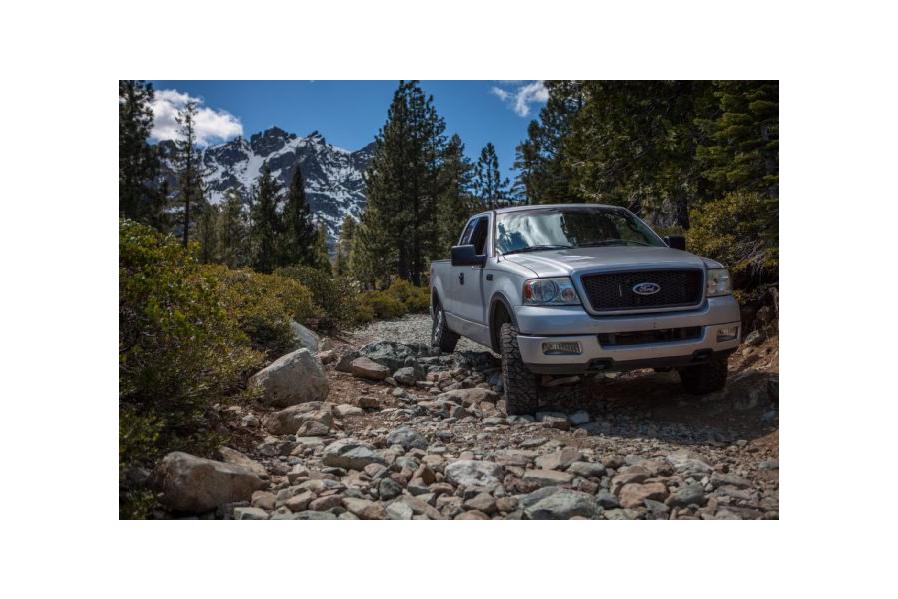Do You Know What All the Letters on Your Sidewall Mean?
February 23, 2018
Harry Wagner Contributor
Tires are your vehicle’s connection to the road, and they are one of the biggest expenses associated with your vehicle. As a result, tire shopping can be intimidating. Metric and standard sizing, LT versus P Metric, load range and rating—it can be overwhelming, but it doesn’t have to be. We are here to help you decipher the information on your tire’s sidewall and help you make sense of it all.
In general, the load range (expressed as C, D, E, and so on) corresponds to the ply rating. C is a six-ply rating, D an eight-ply, E a 10-ply. This is not the actual number of plies but rather a rating system that dates back to when bias-ply tires were common. Radial construction is the most common in modern tires, but bias-ply tires are still offered for off-road use. A radial tire allows the sidewall and the tread to function as two independent features of the tire. As the name implies, radial tires use steel belts that travel around the radius of the tire carcass at a 90-degree angle to the center of the tire. As a result, the ride quality and tread life tend to be better on a radial tire than a bias-ply tire.
Floatation sizing is pretty easy to understand. The first number indicates the tire's diameter in inches (in this case 35 inches tall). The next number (12.50) is the width, and the “R” that follows indicates that this is a radial tire. The last number (18) is the wheel diameter in inches. Like we said, pretty easy.
The DOT Tire Identification Number is perhaps the most mystifying piece of information on your tire’s sidewall. DOT stands for Department of Transportation—that part’s easy enough. This is followed by 10 to 12 characters that can be used to identify the manufacturing location, tire size, and manufacturer's specifications, along with the week and year the tire was manufactured. For instance, 73BNP4F2814 breaks down as follows: 73 is the plant code, BN is the tire size, and P4F is the tire type. This information is only really useful to us in the event there is a tire recall. The last four numbers are important though, particularly when buying used tires. The month and year this tire was manufactured was “2814”—the 28th week of 2014.
Another consideration is how a larger tire will affect your speedometer. We often here “my speedometer is 5 mph off” but your speedometer is actually a percentage off, not a fixed number of miles per hour. You can calculate the percentage by dividing the new tire size by the old tire size. And not just the overall diameter. For the most accurate measurement, check the static load radius of the tire, or the distance from the ground to the center of the hub.
Take this measurement and double it to get your actual working diameter. Note that all tires tend to measure smaller than they are labeled, and the amount varies by model and manufacturer, so to be accurate you need to physically measure the height of the old tire and the new tire. More math formulas can be found in the captions; they are key to deciphering the information on your sidewalls.
Metric sizing is more common these days than floatation sizing and, like the rest of the metric system, can seem a bit foreign. In this example, “295” is the section width, in millimeters. The larger the number, the wider the tire. “70” is what is called the aspect ratio, which means that the sidewall is 70 percent of the section width (70 percent of 295 mm is the sidewall height). A higher aspect ratio results in a taller sidewall, but also a wider section width with the same aspect ratio also results in a physically taller sidewall. After all that metric math, “18” is the rim diameter in inches.
Nitto offers the Terra Grappler G2 tire in both P metric and LT offerings. In the 265/70R17 size, the LT tire has 3/32 inch more tread depth, weighs 5 pounds more, and is rated to carry 500 pounds more per corner. All in the same model tire with the same tread pattern. The tradeoff is the LT is heavier than the P metric and, as Grey Poupon connoisseurs would want to know, may offer a slight degradation in perceived ride quality over the P metric.
Starting with 2008 model year cars and light trucks, a Tire Pressure Monitoring System (TPMS) has been required for all new vehicles sold in the United States. Many oversized tires can achieve the same carrying capacity with lower air pressure though (through the same volume of air), causing the TPMS light to illuminate on the dash. Some programmers, such as Superchip’s Flashcal, can disable the TPMS sensors to run lower air pressure.
The load range letter indicates how much weight a tire can carry. The higher the letter, the more weight the tire can safely carry. Note that maximum load rating values are given at maximum inflation pressures; lower pressures can hold less of a load but provide better ride quality if you aren’t carrying a lot of weight. Higher load ratings generally suggest a stronger tire for off-road use, with the tradeoff being that the stiffer tire might not conform as much to the terrain.
Load ratings are expressed in a pair of three-digit numbers, such as 125/122. “125” denotes that each tire can carry 3,638 pounds at the maximum inflation pressure. The second number (122) refers to the load rating on a single tire in a dual-rear-wheel application. A letter such as “Q” refers to the tire’s speed rating. In this case, the tire is rated at 99 mph for continuous use. The higher the letter, the faster the tire is rated to travel.
Some tire manufacturers apply yellow dots to indicate the tire’s light balance point and to help you balance the assembly while mounting the tire. The yellow dots should be aligned with the valve stem on both steel and aluminum wheels since this is the wheel’s heavy balance point. This will help minimize the amount of weight needed to balance a tire and wheel assembly.
Shopping for used tires? You will want to look at the last four numbers of the DOT code to determine just how old the tires are. Even if they have full tread, an older tire, particularly one that has spent a lot of time in direct sunlight, can be compromised. “4117” is the month and year that this tire was manufactured. So this tire was made in the 41st week of 2017.
Some tires are directional and/or asymmetrical, requiring them to be mounted in a specific orientation. A directional tire is one that has differing tread patterns fore and aft, while an asymmetric tire has different tread patterns across the face of the tire (inside to outside). Directional tires feature arrows on the sidewall that indicate what direction the tire should rotate when the vehicle is moving forward. Asymmetrical tires have the label "outside" on the side of the tire that should face outward from the vehicle.
“M+S” denotes a mud and snow tire, which may get you past the Department of Transportation road workers on a snowy road, but the rating really doesn’t mean a whole lot. The Three Peak Mountain Snowflake has more stringent requirements. In order to meet this standard, the tire must attain a traction index equal to, or greater than, 110 (compared to a reference tire, which is rated 100) during traction tests specified by the ASTM on packed snow.



